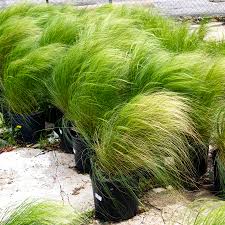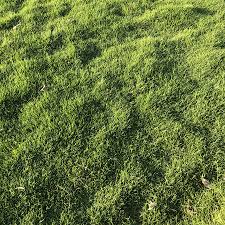Mexican Grass, scientifically known as Stenotaphrum secundatum, is a type of grass that grows in the warm and tropical regions of Mexico. This grass is also commonly referred to as St. Augustine grass. It’s a popular choice for lawns and landscapes due to its lush appearance and ability to thrive in various conditions.
Mexican Grass has broad, flat blades that are a vibrant green color. It forms a dense and carpet-like covering on the ground, making it perfect for areas where you want a thick and soft surface to walk on. The grass has a creeping growth habit, spreading out through above-ground runners called stolons. This helps it quickly cover bare spots and create a uniform lawn.
One of the remarkable features of Mexican Grass is its adaptability. It can grow well in both sunny and partially shaded areas, making it suitable for gardens with diverse lighting conditions. It’s also known for its tolerance to salt, which makes it a suitable choice for coastal regions where salt from the ocean might affect other types of grass.
Proper care is important to keep Mexican Grass looking its best. Regular mowing, usually once a week, helps maintain its height and density. Watering is crucial, especially during dry periods, but it’s important not to overwater to avoid issues like fungal diseases. Applying a balanced fertilizer a few times a year can help keep the grass healthy and vibrant.
Due to its adaptability and visually pleasing characteristics, Mexican Grass has been a popular choice not only in Mexico but also in various parts of the world with similar climates. It can turn a dull yard into a lush and inviting space for families to enjoy. Whether it’s for playing, picnicking, or simply lounging, Mexican Grass provides a comfortable and appealing environment.
Read Also: Litter Management: How often it must be changed
Growing and Care Guide of Mexican grass

Here’s a simple guide to growing and caring for Mexican Grass (Stenotaphrum secundatum):
Growing Mexican Grass
1. Choose the Right Area: Mexican Grass prefers warm and tropical climates. Ensure that the area receives plenty of sunlight, but it can also tolerate partial shade.
2. Prepare the Soil: The soil should be well-draining and slightly acidic to neutral pH. You can test the soil using a pH kit available at garden stores.
3. Planting or Seeding: You can establish Mexican Grass either by planting sod (pre-grown grass patches) or by seeding. Sod provides quicker results, while seeding is more cost-effective.
4. Watering: After planting, water the grass deeply to encourage root growth. Keep the soil consistently moist until the grass establishes itself.
Caring for Mexican Grass
1. Mowing: Regular mowing is essential to keep the grass at a healthy height. Aim to mow when the grass is about one-third taller than its desired height.
2. Watering: Mexican Grass has good drought tolerance, but it still needs regular watering, especially during dry spells. Water deeply and infrequently to encourage deep root growth.
3. Fertilizing: Apply a balanced fertilizer in spring and summer to promote healthy growth. Follow the instructions on the fertilizer packaging for proper application rates.
4. Weed Control: Regular mowing and proper lawn care practices can help prevent weed growth. If weeds do appear, consider using a selective herbicide designed for use on St. Augustine grass.
5. Pest Control: Keep an eye out for pests like chinch bugs and sod webworms, which can damage the grass. If necessary, use appropriate insecticides to control infestations.
6. Aeration: Aerating the soil by perforating it with holes can help improve air circulation and water penetration. This should be done annually, preferably in spring or early summer.
7. Disease Prevention: Proper watering practices and good lawn care can help prevent common diseases like brown patch. Ensure proper drainage to avoid waterlogged areas.
8. Overseeding: If your Mexican Grass lawn develops thin spots, consider overseeding with appropriate grass seeds to maintain its lush appearance.
9. Winter Care: Mexican Grass may go dormant in cooler months. Reduce watering during this time and avoid heavy foot traffic on the grass to prevent damage.
10. Traffic Management: While Mexican Grass is durable, heavy foot traffic can still cause wear and tear. Use stepping stones or pathways to divert traffic and protect the grass.
By following these simple steps, you can successfully grow and maintain a healthy and vibrant Mexican Grass lawn, adding beauty and comfort to your outdoor space.
Benefits and Uses of Mexican grass

Below are the benefits and uses of Mexican Grass (Stenotaphrum secundatum):
1. Lawn Aesthetics: Mexican Grass is known for its lush and vibrant green appearance, making it a popular choice for creating beautiful lawns and landscapes. Its dense growth and soft texture provide a welcoming outdoor space.
2. Erosion Control: Due to its spreading growth habit, Mexican Grass is effective at stabilizing soil and preventing erosion on slopes and banks.
3. Heat and Drought Tolerance: This grass variety has good heat and drought tolerance, making it suitable for regions with hot and dry climates. It can maintain its green color even in challenging conditions.
4. Shade Tolerance: Mexican Grass can grow in partially shaded areas, making it a versatile option for yards with varying levels of sunlight.
5. Salt Tolerance: Its ability to tolerate salt makes Mexican Grass a suitable choice for coastal areas where saltwater exposure might affect other types of grass.
6. Play Areas: The soft texture of Mexican Grass makes it a comfortable surface for play areas, where children and pets can run and play without discomfort.
7. Noise Reduction: A well-maintained Mexican Grass lawn can help reduce noise levels, providing a quieter outdoor environment.
8. Air Quality: Like other plants, Mexican Grass contributes to better air quality by absorbing carbon dioxide and releasing oxygen.
9. Wildlife Habitat: A healthy lawn of Mexican Grass can attract beneficial insects and small wildlife, creating a mini-ecosystem in your yard.
10. Cooling Effect: Grass in general has a cooling effect on the environment. A well-covered lawn of Mexican Grass can help lower outdoor temperatures around your home.
11. Economic Value: A well-maintained lawn can increase the value of your property by enhancing its curb appeal.
12. Recreation Areas: Parks, sports fields, and recreational spaces often use Mexican Grass due to its durability and suitability for various activities.
13. Soil Improvement: The grass’s root system can improve soil structure by preventing compaction and promoting better water infiltration.
14. Carbon Sequestration: Like other plants, Mexican Grass contributes to carbon sequestration, helping to mitigate the impacts of climate change.
15. Medicinal Uses: In traditional medicine, extracts from the roots of some St. Augustine grass varieties have been used for their potential health benefits.
By understanding and utilizing these benefits, you can make the most of Mexican Grass in various settings, from residential lawns to larger public spaces, while also contributing positively to the environment.
Read Also: 10 Medicinal Health Benefits of Milicia excelsa (African Teak)
Where to Find Mexican grass near Me/You
Here are three perfect places where you can find or locate Mexican Grass (Stenotaphrum secundatum):
1. Nurseries and Garden Centers: Local nurseries and garden centers are excellent places to find Mexican Grass. They often carry a variety of grass types, including Mexican Grass, in the form of sod or seeds. The staff can provide advice on the best practices for planting and caring for the grass in your specific area.
2. Landscaping Supply Stores: Stores that specialize in landscaping and outdoor supplies may offer Mexican Grass for sale. They might have a variety of options to choose from, including different sizes of sod or seed packages.
3. Online Plant Retailers: Many online plant retailers offer a wide selection of grass varieties, including Mexican Grass. You can browse through different options, read reviews, and have the grass delivered directly to your doorstep. Just make sure to order from a reputable source.
Before making a purchase, it’s a good idea to research the specific needs of Mexican Grass and ensure that it’s well-suited to your climate and intended use. This will help you establish a successful lawn or landscape with this beautiful grass variety.
Read Also: The Role of Middlemen in Marketing
